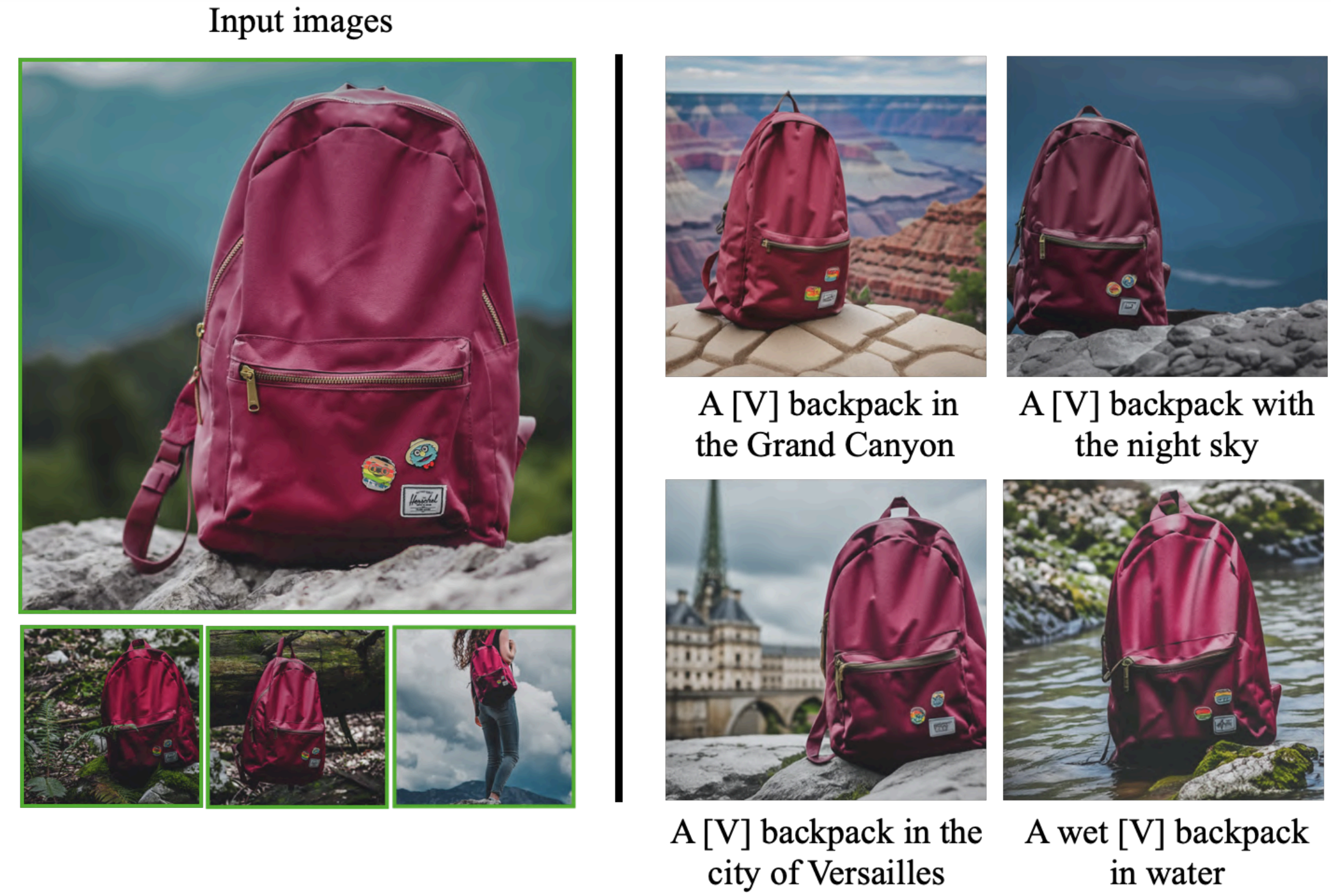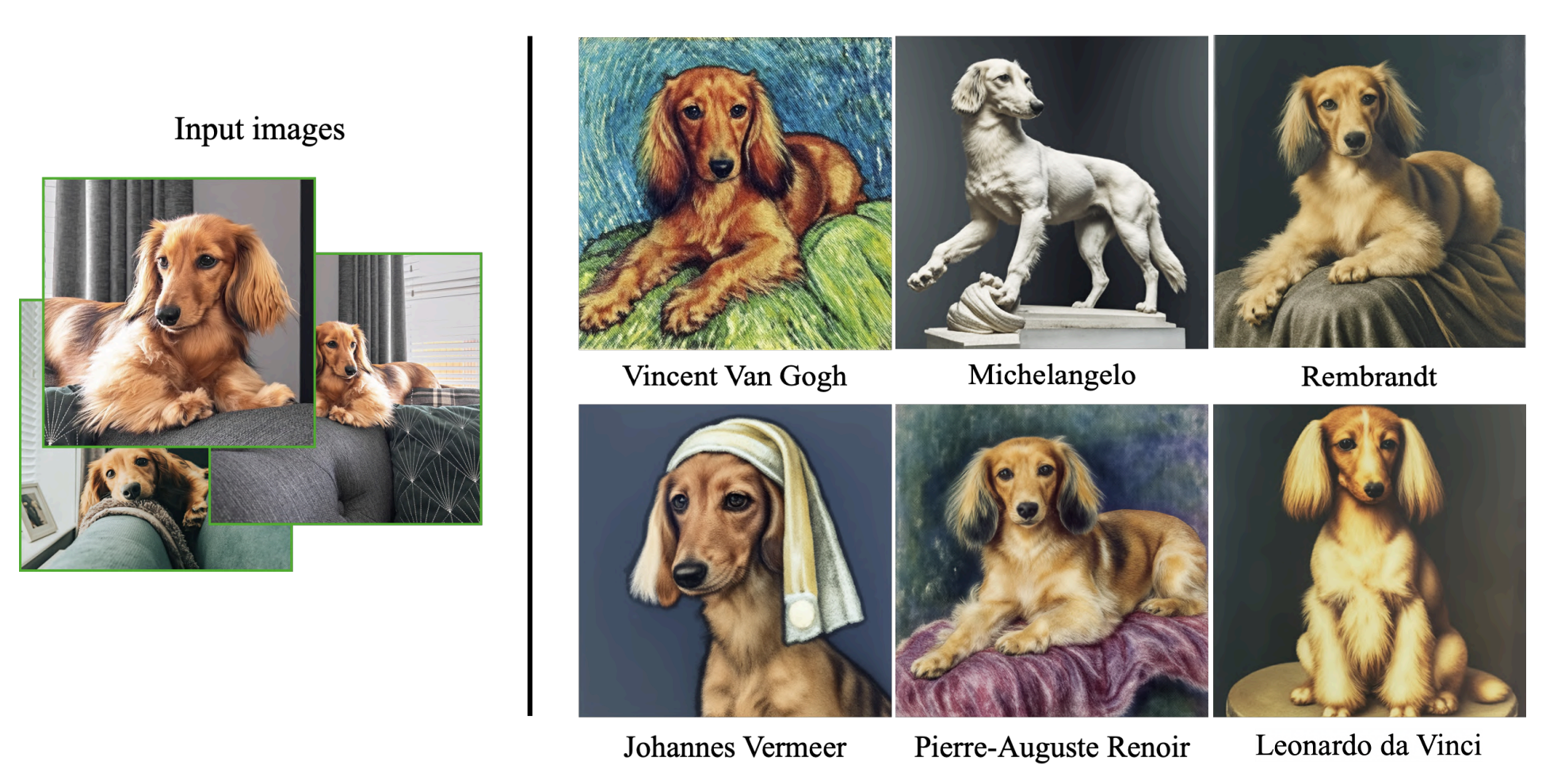DreamBooth
- 원본 링크 : https://keras.io/examples/generative/dreambooth/
- 최종 확인 : 2024-11-22
저자 : Sayak Paul, Chansung Park
생성일 : 2023/02/01
최종 편집일 : 2023/02/05
설명 : DreamBooth 구현.
소개
이 예에서, 우리는 3~5개의 이미지만으로, 텍스트 조건화된 디퓨전 모델에 새로운 시각적 개념을 가르치는 미세 조정 기술인, DreamBooth를 구현합니다. DreamBooth는 Ruiz et al이 DreamBooth: 주제 중심 생성을 위한 텍스트-이미지(Text-to-Image) 디퓨전 모델 미세 조정에서 제안했습니다.
DreamBooth는, 어떤 의미에서, 텍스트 조건화된 디퓨전 모델을 미세 조정하는 기존 방식과 비슷하지만, 몇 가지 단점이 있습니다. 이 예에서는 디퓨전 모델과 이를 미세 조정하는 방법에 대한 기본적인 지식이 있다고 가정합니다. 다음은 빠르게 익숙해지는 데 도움이 될 수 있는 몇 가지 참조 사례입니다.
- KerasCV에서 Stable Diffusion을 사용한 고성능 이미지 생성
- Textual Inversion을 통해 Stable Diffusion에 새로운 개념 가르치기
- Stable Diffusion 미세 조정
먼저, KerasCV와 TensorFlow의 최신 버전을 설치해 보겠습니다.
!pip install -q -U keras_cv==0.6.0
!pip install -q -U tensorflow코드를 실행하는 경우, 최소 24GB의 VRAM이 있는 GPU를 사용하고 있는지 확인하세요.
초기 import
import math
import keras_cv
import matplotlib.pyplot as plt
import numpy as np
import tensorflow as tf
from imutils import paths
from tensorflow import kerasDreamBooth 사용법
… 매우 다재다능합니다. 좋아하는 시각적 개념에 대해 Stable Diffusion을 가르치면 다음을 할 수 있습니다.
흥미로운 방식으로 사물을 재문맥화(Recontextualize)하기

기본 시각적 개념의 예술적 렌더링을 생성하기

그리고 다른 많은 응용을 할 수 있습니다. 이와 관련하여 원본 DreamBooth 논문을 확인해 보시기 바랍니다.
인스턴스 및 클래스 이미지 다운로드
DreamBooth는 “사전 보존(prior preservation)“이라는 기술을 사용하여, 미세 조정된 모델이 도입하는 시각적 개념의 일부 사전 의미(prior semantics)를 여전히 보존할 수 있도록, 트레이닝 절차를 의미 있게 안내합니다. “사전 보존"이라는 개념에 대해 자세히 알아보려면, 이 문서를 참조하세요.
여기서, DreamBooth에 특정한 몇 가지 핵심 용어를 소개할 필요가 있습니다.
- 고유 클래스 (Unique class): 예로는 “개”, “사람” 등이 있습니다. 이 예에서는, “개"를 사용합니다.
- 고유 식별자 (Unique identifier): “인스턴스 프롬프트"를 형성하는 동안, 고유 클래스 앞에 붙는 고유 식별자입니다. 이 예에서는, 이 고유 식별자로 “sks"를 사용합니다.
- 인스턴스 프롬프트 (Instance prompt): “인스턴스 이미지"를 가장 잘 설명하는 프롬프트를 나타냅니다. 프롬프트의 예로는 “f"a photo of {unique_id} {unique_class}“가 있습니다. 따라서, 이 예에서는 “a photo of sks dog"가 됩니다.
- 클래스 프롬프트 (Class prompt): 고유 식별자가 없는 프롬프트를 나타냅니다. 이 프롬프트는 사전 보존을 위해 “클래스 이미지"를 생성하는 데 사용됩니다. 예를 들어, 이 프롬프트는 “개 사진"입니다.
- 인스턴스 이미지 (Instance images): 가르치려는 시각적 개념을 나타내는 이미지, 즉 “인스턴스 프롬프트"를 나타냅니다. 이 숫자는 일반적으로 3~5개에 불과합니다. 일반적으로 이러한 이미지는 직접 수집합니다.
- 클래스 이미지 (Class images): DreamBooth 트레이닝에서 사전 보존을 사용하기 위해, “클래스 프롬프트"를 사용하여 생성된 이미지를 나타냅니다. 이러한 클래스 이미지를 생성하기 위해, 미세 조정하기 전에 사전 트레이닝된 모델을 활용합니다. 일반적으로, 200~300개의 클래스 이미지로 충분합니다.
코드에서, 이 생성 과정은 매우 간단해 보입니다.
from tqdm import tqdm
import numpy as np
import hashlib
import keras_cv
import PIL
import os
class_images_dir = "class-images"
os.makedirs(class_images_dir, exist_ok=True)
model = keras_cv.models.StableDiffusion(img_width=512, img_height=512, jit_compile=True)
class_prompt = "a photo of dog"
num_imgs_to_generate = 200
for i in tqdm(range(num_imgs_to_generate)):
images = model.text_to_image(
class_prompt,
batch_size=3,
)
idx = np.random.choice(len(images))
selected_image = PIL.Image.fromarray(images[idx])
hash_image = hashlib.sha1(selected_image.tobytes()).hexdigest()
image_filename = os.path.join(class_images_dir, f"{hash_image}.jpg")
selected_image.save(image_filename)이 예제의 런타임을 짧게 유지하기 위해, 이 예제의 작성자는 이 노트북을 사용하여, 일부 클래스 이미지를 생성했습니다.
참고 사전 보존은 DreamBooth에서 사용되는 선택적 기술이지만, 생성된 이미지의 품질을 개선하는 데 거의 항상 도움이 됩니다.
instance_images_root = tf.keras.utils.get_file(
origin="https://huggingface.co/datasets/sayakpaul/sample-datasets/resolve/main/instance-images.tar.gz",
untar=True,
)
class_images_root = tf.keras.utils.get_file(
origin="https://huggingface.co/datasets/sayakpaul/sample-datasets/resolve/main/class-images.tar.gz",
untar=True,
)이미지 시각화
먼저, 이미지 경로를 로드해 보겠습니다.
instance_image_paths = list(paths.list_images(instance_images_root))
class_image_paths = list(paths.list_images(class_images_root))그런 다음, 경로에서 이미지를 로드합니다.
def load_images(image_paths):
images = [np.array(keras.utils.load_img(path)) for path in image_paths]
return images그리고, 로드된 이미지를 그리기 위해 유틸리티 함수를 사용합니다.
def plot_images(images, title=None):
plt.figure(figsize=(20, 20))
for i in range(len(images)):
ax = plt.subplot(1, len(images), i + 1)
if title is not None:
plt.title(title)
plt.imshow(images[i])
plt.axis("off")인스턴스 이미지:
plot_images(load_images(instance_image_paths[:5]))
클래스 이미지:
plot_images(load_images(class_image_paths[:5]))
데이터세트 준비
데이터 세트 준비에는 두 단계가 포함됩니다. (1) 캡션 준비, (2) 이미지 처리.
캡션 준비
# 사전 보존을 사용하고 있으므로,
# 사용하는 인스턴스 이미지의 수를 맞춰야 합니다.
# 인스턴스 이미지 경로를 반복하기만 하면 됩니다.
new_instance_image_paths = []
for index in range(len(class_image_paths)):
instance_image = instance_image_paths[index % len(instance_image_paths)]
new_instance_image_paths.append(instance_image)
# 우리는 단지 이미지 당 프롬프트 / 캡션을 반복할 뿐입니다.
unique_id = "sks"
class_label = "dog"
instance_prompt = f"a photo of {unique_id} {class_label}"
instance_prompts = [instance_prompt] * len(new_instance_image_paths)
class_prompt = f"a photo of {class_label}"
class_prompts = [class_prompt] * len(class_image_paths)다음으로, 컴퓨팅을 절약하기 위해 프롬프트를 임베드합니다.
import itertools
# 패딩 토큰과 최대 프롬프트 길이는 텍스트 인코더에 따라 다릅니다.
# 다른 텍스트 인코더를 사용하는 경우, 이에 따라 변경해야 합니다.
padding_token = 49407
max_prompt_length = 77
# 토크나이저를 로드합니다.
tokenizer = keras_cv.models.stable_diffusion.SimpleTokenizer()
# 토큰을 토큰화하고 패딩하는 메서드.
def process_text(caption):
tokens = tokenizer.encode(caption)
tokens = tokens + [padding_token] * (max_prompt_length - len(tokens))
return np.array(tokens)
# 토큰화된 캡션을 배열로 정리합니다.
tokenized_texts = np.empty(
(len(instance_prompts) + len(class_prompts), max_prompt_length)
)
for i, caption in enumerate(itertools.chain(instance_prompts, class_prompts)):
tokenized_texts[i] = process_text(caption)
# 또한 트레이닝 중 메모리를 절약하기 위해, 텍스트 임베딩을 미리 계산합니다.
POS_IDS = tf.convert_to_tensor([list(range(max_prompt_length))], dtype=tf.int32)
text_encoder = keras_cv.models.stable_diffusion.TextEncoder(max_prompt_length)
gpus = tf.config.list_logical_devices("GPU")
# 계산이 GPU에서 수행되도록 합니다.
# GPU가 있는 경우, 자동으로 수행된다는 점에 유의하세요.
# 이 예는 더 명확하게 수행하는 방법을 보여주기 위한 것입니다.
with tf.device(gpus[0].name):
embedded_text = text_encoder(
[tf.convert_to_tensor(tokenized_texts), POS_IDS], training=False
).numpy()
# text_encoder가 GPU 공간을 차지하지 않도록 합니다.
del text_encoder이미지 준비
resolution = 512
auto = tf.data.AUTOTUNE
augmenter = keras.Sequential(
layers=[
keras_cv.layers.CenterCrop(resolution, resolution),
keras_cv.layers.RandomFlip(),
keras.layers.Rescaling(scale=1.0 / 127.5, offset=-1),
]
)
def process_image(image_path, tokenized_text):
image = tf.io.read_file(image_path)
image = tf.io.decode_png(image, 3)
image = tf.image.resize(image, (resolution, resolution))
return image, tokenized_text
def apply_augmentation(image_batch, embedded_tokens):
return augmenter(image_batch), embedded_tokens
def prepare_dict(instance_only=True):
def fn(image_batch, embedded_tokens):
if instance_only:
batch_dict = {
"instance_images": image_batch,
"instance_embedded_texts": embedded_tokens,
}
return batch_dict
else:
batch_dict = {
"class_images": image_batch,
"class_embedded_texts": embedded_tokens,
}
return batch_dict
return fn
def assemble_dataset(image_paths, embedded_texts, instance_only=True, batch_size=1):
dataset = tf.data.Dataset.from_tensor_slices((image_paths, embedded_texts))
dataset = dataset.map(process_image, num_parallel_calls=auto)
dataset = dataset.shuffle(5, reshuffle_each_iteration=True)
dataset = dataset.batch(batch_size)
dataset = dataset.map(apply_augmentation, num_parallel_calls=auto)
prepare_dict_fn = prepare_dict(instance_only=instance_only)
dataset = dataset.map(prepare_dict_fn, num_parallel_calls=auto)
return dataset데이터세트 모으기
instance_dataset = assemble_dataset(
new_instance_image_paths,
embedded_text[: len(new_instance_image_paths)],
)
class_dataset = assemble_dataset(
class_image_paths,
embedded_text[len(new_instance_image_paths) :],
instance_only=False,
)
train_dataset = tf.data.Dataset.zip((instance_dataset, class_dataset))모양 확인
이제 데이터 세트가 준비되었으니, 그 안에 무엇이 있는지 잠깐 확인해 보겠습니다.
sample_batch = next(iter(train_dataset))
print(sample_batch[0].keys(), sample_batch[1].keys())
for k in sample_batch[0]:
print(k, sample_batch[0][k].shape)
for k in sample_batch[1]:
print(k, sample_batch[1][k].shape)결과
dict_keys(['instance_images', 'instance_embedded_texts']) dict_keys(['class_images', 'class_embedded_texts'])
instance_images (1, 512, 512, 3)
instance_embedded_texts (1, 77, 768)
class_images (1, 512, 512, 3)
class_embedded_texts (1, 77, 768)트레이닝하는 동안, 이러한 키를 사용하여 이미지와 텍스트 임베딩을 수집하고 이에 따라 연결합니다.
DreamBooth 트레이닝 루프
DreamBooth 트레이닝 루프는 Hugging Face의 Diffusers 팀에서 제공하는 이 스크립트에서 많은 영감을 받았습니다. 하지만, 주의해야 할 중요한 차이점이 있습니다. 이 예에서는 UNet(노이즈 예측을 담당하는 모델)만 미세 조정하고, 텍스트 인코더는 미세 조정하지 않습니다. 텍스트 인코더의 추가 미세 조정도 수행하는 구현을 찾고 있다면, 이 저장소를 참조하세요.
import tensorflow.experimental.numpy as tnp
class DreamBoothTrainer(tf.keras.Model):
# 참조:
# https://github.com/huggingface/diffusers/blob/main/examples/dreambooth/train_dreambooth.py
def __init__(
self,
diffusion_model,
vae,
noise_scheduler,
use_mixed_precision=False,
prior_loss_weight=1.0,
max_grad_norm=1.0,
**kwargs,
):
super().__init__(**kwargs)
self.diffusion_model = diffusion_model
self.vae = vae
self.noise_scheduler = noise_scheduler
self.prior_loss_weight = prior_loss_weight
self.max_grad_norm = max_grad_norm
self.use_mixed_precision = use_mixed_precision
self.vae.trainable = False
def train_step(self, inputs):
instance_batch = inputs[0]
class_batch = inputs[1]
instance_images = instance_batch["instance_images"]
instance_embedded_text = instance_batch["instance_embedded_texts"]
class_images = class_batch["class_images"]
class_embedded_text = class_batch["class_embedded_texts"]
images = tf.concat([instance_images, class_images], 0)
embedded_texts = tf.concat([instance_embedded_text, class_embedded_text], 0)
batch_size = tf.shape(images)[0]
with tf.GradientTape() as tape:
# 잠재 공간에 이미지를 프로젝션하고, 샘플을 추출합니다.
latents = self.sample_from_encoder_outputs(self.vae(images, training=False))
# 여기서 마법의 숫자에 대해 자세히 알아보세요:
# https://keras.io/examples/generative/fine_tune_via_textual_inversion/
latents = latents * 0.18215
# 잠재(latents)에 추가할 샘플 노이즈입니다.
noise = tf.random.normal(tf.shape(latents))
# 각 이미지에 대해 무작위 타임스텝을 샘플링합니다.
timesteps = tnp.random.randint(
0, self.noise_scheduler.train_timesteps, (batch_size,)
)
# 각 타임스텝의 노이즈 크기에 따라, 잠재(latents)에 노이즈를 추가합니다.
# (이것은 전방(forward) 확산 과정입니다)
noisy_latents = self.noise_scheduler.add_noise(
tf.cast(latents, noise.dtype), noise, timesteps
)
# 지금은 샘플링된 노이즈에 따라, 예측 타입에 따른 손실 대상을 구합니다.
target = noise # noise_schedule.predict_epsilon == True
# residual 노이즈를 예측하고, 손실을 계산합니다.
timestep_embedding = tf.map_fn(
lambda t: self.get_timestep_embedding(t), timesteps, dtype=tf.float32
)
model_pred = self.diffusion_model(
[noisy_latents, timestep_embedding, embedded_texts], training=True
)
loss = self.compute_loss(target, model_pred)
if self.use_mixed_precision:
loss = self.optimizer.get_scaled_loss(loss)
# 확산 모델의 매개변수를 업데이트합니다.
trainable_vars = self.diffusion_model.trainable_variables
gradients = tape.gradient(loss, trainable_vars)
if self.use_mixed_precision:
gradients = self.optimizer.get_unscaled_gradients(gradients)
gradients = [tf.clip_by_norm(g, self.max_grad_norm) for g in gradients]
self.optimizer.apply_gradients(zip(gradients, trainable_vars))
return {m.name: m.result() for m in self.metrics}
def get_timestep_embedding(self, timestep, dim=320, max_period=10000):
half = dim // 2
log_max_period = tf.math.log(tf.cast(max_period, tf.float32))
freqs = tf.math.exp(
-log_max_period * tf.range(0, half, dtype=tf.float32) / half
)
args = tf.convert_to_tensor([timestep], dtype=tf.float32) * freqs
embedding = tf.concat([tf.math.cos(args), tf.math.sin(args)], 0)
return embedding
def sample_from_encoder_outputs(self, outputs):
mean, logvar = tf.split(outputs, 2, axis=-1)
logvar = tf.clip_by_value(logvar, -30.0, 20.0)
std = tf.exp(0.5 * logvar)
sample = tf.random.normal(tf.shape(mean), dtype=mean.dtype)
return mean + std * sample
def compute_loss(self, target, model_pred):
# 노이즈와 model_pred를 두 부분으로 나누고, (Chunk하고)
# 각 부분의 손실을 따로 계산합니다.
# 입력의 전반부는 인스턴스 샘플이 있고 후반부는 클래스 샘플이 있으므로,
# 그에 따라 청킹을 수행합니다.
model_pred, model_pred_prior = tf.split(
model_pred, num_or_size_splits=2, axis=0
)
target, target_prior = tf.split(target, num_or_size_splits=2, axis=0)
# 인스턴스 손실을 계산합니다.
loss = self.compiled_loss(target, model_pred)
# 사전 손실(prior loss)을 계산합니다.
prior_loss = self.compiled_loss(target_prior, model_pred_prior)
# 사전 손실을 인스턴스 손실에 합산합니다.
loss = loss + self.prior_loss_weight * prior_loss
return loss
def save_weights(self, filepath, overwrite=True, save_format=None, options=None):
# 이 메서드를 재정의하면,
# 이 트레이너 클래스에서 `ModelCheckpoint` 콜백을 직접 사용할 수 있습니다.
# 이 경우, 미세 조정 중에 트레이닝하므로, `diffusion_model`만 체크포인트로 사용합니다.
self.diffusion_model.save_weights(
filepath=filepath,
overwrite=overwrite,
save_format=save_format,
options=options,
)
def load_weights(self, filepath, by_name=False, skip_mismatch=False, options=None):
# 마찬가지로 `load_weights()`를 재정의하여,
# 트레이너 클래스 객체에서 직접 호출할 수 있도록 합니다.
self.diffusion_model.load_weights(
filepath=filepath,
by_name=by_name,
skip_mismatch=skip_mismatch,
options=options,
)트레이너 초기화
# 텐서 코어가 있는 GPU를 사용하지 않는 경우, 주석 처리하세요.
tf.keras.mixed_precision.set_global_policy("mixed_float16")
use_mp = True # 텐서 코어가 있는 GPU를 사용하지 않는 경우, False로 설정하세요.
image_encoder = keras_cv.models.stable_diffusion.ImageEncoder()
dreambooth_trainer = DreamBoothTrainer(
diffusion_model=keras_cv.models.stable_diffusion.DiffusionModel(
resolution, resolution, max_prompt_length
),
# 인코더에서 최상위 레이어를 제거하면, 분산이 제거되고 평균만 반환됩니다.
vae=tf.keras.Model(
image_encoder.input,
image_encoder.layers[-2].output,
),
noise_scheduler=keras_cv.models.stable_diffusion.NoiseScheduler(),
use_mixed_precision=use_mp,
)
# 이러한 하이퍼파라미터는 Hugging Face의 이 튜토리얼에서 나왔습니다.
# https://github.com/huggingface/diffusers/tree/main/examples/dreambooth
learning_rate = 5e-6
beta_1, beta_2 = 0.9, 0.999
weight_decay = (1e-2,)
epsilon = 1e-08
optimizer = tf.keras.optimizers.experimental.AdamW(
learning_rate=learning_rate,
weight_decay=weight_decay,
beta_1=beta_1,
beta_2=beta_2,
epsilon=epsilon,
)
dreambooth_trainer.compile(optimizer=optimizer, loss="mse")트레이닝!
먼저, 트레이닝에 필요한 에포크 수를 계산합니다.
num_update_steps_per_epoch = train_dataset.cardinality()
max_train_steps = 800
epochs = math.ceil(max_train_steps / num_update_steps_per_epoch)
print(f"Training for {epochs} epochs.")결과
Training for 4 epochs.그리고, 트레이닝을 시작합니다!
ckpt_path = "dreambooth-unet.h5"
ckpt_callback = tf.keras.callbacks.ModelCheckpoint(
ckpt_path,
save_weights_only=True,
monitor="loss",
mode="min",
)
dreambooth_trainer.fit(train_dataset, epochs=epochs, callbacks=[ckpt_callback])결과
Epoch 1/4
200/200 [==============================] - 301s 462ms/step - loss: 0.1203
Epoch 2/4
200/200 [==============================] - 94s 469ms/step - loss: 0.1139
Epoch 3/4
200/200 [==============================] - 94s 469ms/step - loss: 0.1016
Epoch 4/4
200/200 [==============================] - 94s 469ms/step - loss: 0.1231
<keras.callbacks.History at 0x7f19726600a0>실험과 추론
우리는 이 예제의 약간 수정된 버전으로 다양한 실험을 했습니다. 우리의 실험은 이 저장소를 기반으로 하며, Hugging Face의 이 블로그 게시물에서 영감을 받았습니다.
먼저, 미세 조정된 체크포인트를 사용하여, 추론을 실행하는 방법을 살펴보겠습니다.
# 새로운 Stable Diffusion 모델을 초기화합니다.
dreambooth_model = keras_cv.models.StableDiffusion(
img_width=resolution, img_height=resolution, jit_compile=True
)
dreambooth_model.diffusion_model.load_weights(ckpt_path)
# 프롬프트에서 고유 식별자와 클래스가 어떻게 사용되었는지 주목하세요.
prompt = f"A photo of {unique_id} {class_label} in a bucket"
num_imgs_to_gen = 3
images_dreamboothed = dreambooth_model.text_to_image(prompt, batch_size=num_imgs_to_gen)
plot_images(images_dreamboothed, prompt)결과
By using this model checkpoint, you acknowledge that its usage is subject to the terms of the CreativeML Open RAIL-M license at https://raw.githubusercontent.com/CompVis/stable-diffusion/main/LICENSE
50/50 [==============================] - 42s 160ms/step
이제, 우리가 UNet과 함께 텍스트 인코더를 미세 조정한, 다른 실험에서 체크포인트를 로드해 보겠습니다.
unet_weights = tf.keras.utils.get_file(
origin="https://huggingface.co/chansung/dreambooth-dog/resolve/main/lr%409e-06-max_train_steps%40200-train_text_encoder%40True-unet.h5"
)
text_encoder_weights = tf.keras.utils.get_file(
origin="https://huggingface.co/chansung/dreambooth-dog/resolve/main/lr%409e-06-max_train_steps%40200-train_text_encoder%40True-text_encoder.h5"
)
dreambooth_model.diffusion_model.load_weights(unet_weights)
dreambooth_model.text_encoder.load_weights(text_encoder_weights)
images_dreamboothed = dreambooth_model.text_to_image(prompt, batch_size=num_imgs_to_gen)
plot_images(images_dreamboothed, prompt)결과
Downloading data from https://huggingface.co/chansung/dreambooth-dog/resolve/main/lr%409e-06-max_train_steps%40200-train_text_encoder%40True-unet.h5
3439088208/3439088208 [==============================] - 67s 0us/step
Downloading data from https://huggingface.co/chansung/dreambooth-dog/resolve/main/lr%409e-06-max_train_steps%40200-train_text_encoder%40True-text_encoder.h5
492466760/492466760 [==============================] - 9s 0us/step
50/50 [==============================] - 8s 159ms/step
text_to_image()에서 이미지를 생성하는 데 필요한 기본 단계 수는 50 입니다. 이를 100으로 늘려보겠습니다.
images_dreamboothed = dreambooth_model.text_to_image(
prompt, batch_size=num_imgs_to_gen, num_steps=100
)
plot_images(images_dreamboothed, prompt)결과
100/100 [==============================] - 16s 159ms/step
다양한 프롬프트로 자유롭게 실험해 보세요. (고유 식별자와 클래스 레이블을 추가하는 것을 잊지 마세요!) 결과가 어떻게 바뀌는지 살펴보세요. 저희 코드베이스와 더 많은 실험 결과를 여기에서 확인해 보세요. 이 블로그 게시물을 읽고 더 많은 아이디어를 얻을 수도 있습니다.
Acknowledgements
- Hugging Face에서 제공한 DreamBooth 예제 스크립트 덕분에 초기 구현을 빠르게 준비하는 데 많은 도움이 되었습니다.
- DreamBooth를 사람의 얼굴에 적용하는 것은 어려울 수 있습니다. 여기에 몇 가지 일반적인 권장 사항을 정리했습니다. 이러한 문제에 도움을 주신 Abhishek Thakur에게 감사드립니다.